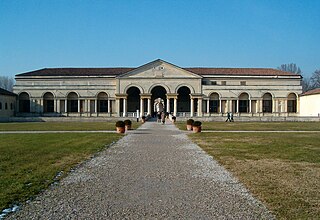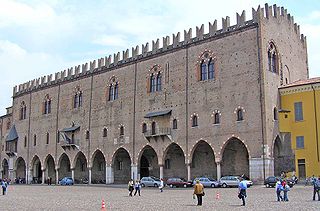
The Castello di San Giorgio is part of the Ducal palace of Mantua. It is a moated rectangular castle, each of which's four corners has a large tower and the moat is crossed by three drawbridges.

The Castello di San Giorgio is part of the Ducal palace of Mantua. It is a moated rectangular castle, each of which's four corners has a large tower and the moat is crossed by three drawbridges.
It was built between 1395 and 1406 on the ruins of the church of Santa Maria di Capo di Bove for Francesco I Gonzaga, to designs by Bartolino da Novara. Ludovico III Gonzaga gave over his rooms in the "Corte Vecchia" to pope Pius II for the Council of Mantua in 1459 - that year, he commissioned Luca Fancelli to rebuild the castle as a palazzo rather than as a defensible castle. He also commissioned the frescoes of the castle Camera degli Sposi. In 1490 the castle became the site of the studiolo of Isabella d'Este, remaining there until she moved it to the "Corte Vecchia" in 1519-1522. In 1496 the condottiero Paolo Vitelli was captured by Francesco II and imprisoned in the castle. It remained the main Gonzaga residence for around a century until Guglielmo Gonzaga moved his apartments to the rebuilt "Corte Vecchia".

In 1810 the Tyrolean fighter Andreas Hofer was imprisoned in the castle before his execution by the Kingdom of Italy. Mantua became part of the Austrian Empire in 1814 and from 1815 it was a maximum security prison for the Empire's political opponents, such as the Belfiore martyrs from 1852 onwards. Others pro-Risorgimento figures imprisoned there included Ciro Menotti and Teresa Arrivabene. The building's structure was damaged by the 2012 Emilia earthquake. [1]

Isabella d'Este was the Marchioness of Mantua and one of the leading women of the Italian Renaissance as a major cultural and political figure.

Mantua is a comune (municipality) in the Italian region of Lombardy, and capital of the province of the same name.

Palazzo del Te, or simply Palazzo Te, is a palace in the suburbs of Mantua, Italy. It is an example of the mannerist style of architecture, and the acknowledged masterpiece of Giulio Romano.

The Castello Sforzesco is a medieval fortification located in Milan, Northern Italy. It was built in the 15th century by Francesco Sforza, Duke of Milan, on the remnants of a 14th-century fortification. Later renovated and enlarged, in the 16th and 17th centuries it was one of the largest citadels in Europe. Extensively rebuilt by Luca Beltrami in 1891–1905, it now houses several of the city's museums and art collections.

Sabbioneta is a town and comune in the province of Mantua, Lombardy region, Northern Italy. It is situated about 30 kilometres (19 mi) north of Parma, not far from the northern bank of the Po River. It is one of I Borghi più belli d'Italia. It was inscribed in the World Heritage List in 2008.

The Palazzo Ducale di Mantova is a group of buildings in Mantua, Lombardy, northern Italy, built between the 14th and the 17th century mainly by the noble family of Gonzaga as their royal residence in the capital of their Duchy. The buildings are connected by corridors and galleries and are enriched by inner courts and wide gardens. The complex includes some 500 rooms and occupies an area of c. 34,000 m2, which make it the sixth largest palace in Europe after the palaces of the Vatican, the Louvre Palace, the Palace of Versailles, the Royal Palace of Caserta and the Castle of Fontainebleau. It has more than 500 rooms and contains seven gardens and eight courtyards. Although most famous for Mantegna's frescos in the Camera degli Sposi, they have many other very significant architectural and painted elements.

Mantua Cathedral in Mantua, Lombardy, northern Italy, is a Roman Catholic cathedral dedicated to Saint Peter. It is the seat of the Bishop of Mantua.

Lorenzo Leonbruno, also known as Lorenzo de Leombeni, was an Italian painter during the early Renaissance period. He was born in Mantua (Mantova), an Italian commune in Lombardy, Italy. Leonbruno is most well known for being commissioned by the court of Francesco Gonzaga, Marquis of Mantua, and his wife Isabella d'Este. The patronage continued with their eldest son Federico II Gonzaga, who was the fifth Marquis of Mantua. Leonbruno was the court painter for the Gonzaga family from 1506–24.

Francesco Gonzaga was an Italian bishop and a Cardinal of the Roman Catholic Church during the reigns of Popes Pius II, Paul II and Sixtus IV.

Frans Geffels, known in Italy as Francesco Geffels, was a Flemish painter, printmaker, architect, stage designer and designer of ephemeral structures for solemn and festive occasions. After training in his native Antwerp, he was mainly active in Mantua, where he was prefetto delle fabbriche to the Duke, a role that gave him the direction of the artistic and construction activities undertaken by the Ducal court. He worked also on projects for the local aristocratic class of Mantua. In addition, he completed projects for the Liechtenstein princes and for the imperial court in Vienna.
Rinaldo Mantovano, also called Domenico Rinaldo, was an Italian painter from Mantua who was active between 1527 and 1539. According to Giorgio Vasari he was the most talented assistant of Giulio Romano during his stay in the service of the Gonzaga Marquis' of Mantua.

The Marquisate or Margraviate of Mantua was a margraviate located in Lombardy, Northern Italy. Placed under the sovereignty of the House of Gonzaga since its erection in 1433, it was further raised to Duchy in 1530.

Bernardino Facciotto (1540–1598) was an Italian military and civil architect who was born and died in Casale Monferrato.

The Palazzo San Sebastiano is a 16th-century palace in Mantua. Built by the Gonzaga family, since 19 March 2005 it has housed Mantua's city museum.
The Studiolo of Isabella d'Este was a special private study, first in castello di San Giorgio, later the Studiolo was moved to the Corte Vecchi apartments in the Ducal Palace in Mantua, designed by, and with a collection of art specially commissioned by Isabella d'Este.
Gian Battista Covo or Battista da Covo was an Italian architect. From 1513 until 1524 he was "Prefect of the Gonzaga Buildings" under Francesco II Gonzaga. He designed the second phase of the Studiolo of Isabella d'Este on the ground floor of the "Corte Vecchia" of the Ducal Palace. In 1524 he started collaborating with Giulio Romano, who that year took over as prefect.

Antonio della Mola was a 16th-century Italian artist who worked in intaglio and wood-inlay, as well as producing sculptures in marble.

The Basilica Palatina di Santa Barbara is the Palatine Chapel of the House of Gonzaga in Mantua, Italy.

The Fasti of the Gonzagas or Gonzaga Cycle is a 1578-1580 cycle of oil on canvas paintings commissioned from Tintoretto and his workshop by Guglielmo Gonzaga to hang in two of the new rooms he had added to the Palazzo Ducale in Mantua. They celebrate the history of the Gonzaga family, particularly its military triumphs in the 15th and 16th centuries, and remained in the city until being taken to Venice in the early 18th century by the tenth and final Gonzaga duke Ferdinando Carlo Gonzaga. There they were bought in 1708 by Maximilian II Emanuel, Elector of Bavaria for his collection in Munich, where they still hang in the Alte Pinakothek.